Words by Chris Hector & Photos by Roz Neave
I am pretty good at scribbling down notes as a lesson progresses, but as we walked down to the arena at Sugarloaf farm, where Hayley Gilbert and Leonie Bramall were starting their session, it was obvious that this was not going to work. Problem one, Leonie has a very soft voice, problem two, although it is a very quiet voice, the delivery is rapid fire. Luckily, Leonie didn’t mind me tracking her around the school with my digital recorder in my hand, doubly lucky because it was an incredibly sophisticated, multi-layered performance…
The subjects were two of our regular clinic stars, Hayley Gilbert and her beautiful young mare, Rubinell – yes, they appeared in our Anna Sophie Fiebelkorn clinic a month or two back, and Hayley was concentrating hard on the words of wisdom from the new visitor…
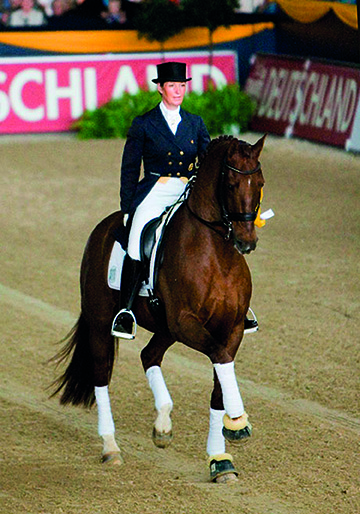
Leonie, a star for her position on the FN training tapes
Leonie became famous as ‘the rider with the perfect position’ in the FN training tapes. At that stage she was doing her time (15 years!) with Jo Hinnemann, since then she has moved on and established her own dressage training centre with her partner, Volke Dusche near Hanover. Although Leonie has been a regular visitor to Queensland over the past few years, this was her first visit down south. Leonie is obviously a gifted instructor, one who gets into the process between horse and rider, she is feeling the interaction every step of the way…
“Give her a bit of a sponging, squeezing, idea with your outside hand, so that you are giving her the feeling that she is going to your outside rein, not backing off. You are sponging and encouraging her to take that contact on the right rein. Give on your inside left hand. You want her to relax her neck, ask her to drop and stretch her neck more positively – we will keep working on that concept.”
“Did you see the rider before you, when his horse really stretched at the end? Often it is better to do that stretching at the end. When the horse is on top of things and hot, you don’t get that stretch. There’s no point trying that stretch at the beginning if the horse is tense and won’t go in front of your leg. Often with these horses, you do the stretching to the end of the ride when they are on your aids and they are open through their necks.”
“When you are making your turns you should be thinking turning into forwards – not forwards as acceleration. Even a piaffing horse that is on the spot, is not going anywhere in acceleration as far as the speed goes, but is keeping the energy moving forwards, stepping up from behind, and that is the important thing, controlling the energy.”
And we are still walking folks!
“Allow her the chance to put her nose down; it is not always about being perfect all the time. Give again, so that the horse actually opens its shoulders. Now you have the walk at the beginning that you had at the end in yesterday’s lesson.”
“Regardless of how much collection you are trying to achieve, you must not deplete the range of motion. A lot of people train horses and shut them off, because it is easier. Okay, they do the tricks, however they lose that natural range of motion. We all want the big movers – we go to the Young Horse classes and the horses there are all big movers, but look at them in two or three years and what happened to that movement? That is one thing that was hammered into me at Jo Hinnemann’s, you must never, never, deplete the horse’s range of motion. Collection is not limiting the range of motion, it is actually enhancing and producing cadence. You should always take care of that.”
“She comes in here to work and she has a calm state of mind, she is willing to open to you at the very beginning. Even though it is windy and the birds are squawking, yes she lives here, but sometimes when horses live in an environment it can be worse. You have a communication working and this is so important, you don’t want to lose that in your training.”
If by now gentle reader you are getting the impression that this is one of those very long, very detailed articles, you are dead right. Quick solutions, like quick results are not on today’s agenda.
“Shorten your reins and trot on. We work on the quality of the work. Regardless of what exercise you ride, the purity of the gaits should always be maintained.”
“Work on that shoulder-in; make sure you’re getting the balance: the hindquarters are staying on the track, the left front leg with the left shoulder has to come in, not the head: the left shoulder is staying in front of you. Work the horse in a sphere, not in a box. Have the idea of working into the third dimension, not just flat like you are watching a TV picture, but the third dimension, real life. Longitudinal connection combined with lateral connection – those two elements, not one or the other, but both of them together.”
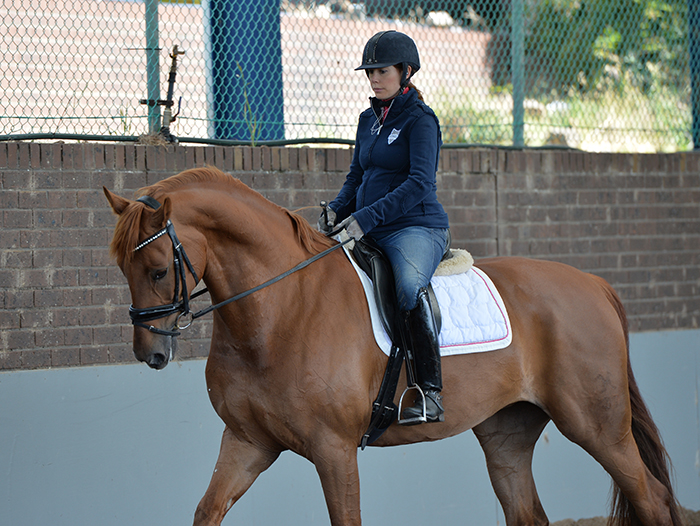
“That’s what creates cadence and that’s how you enhance your collection.”
“When you are asking her to flex, she doesn’t back off the bit, she swings past your contact, so the contact is never hindering the range of motion. Watch the neck, does the neck stay soft, is she accepting your contact on the outside rein?”
“She is allowed to look, yes, but she is not allowed to deviate and change lanes like a crazy driver on the freeway. Don’t change lanes, stay in your lane. I don’t have a problem with horses looking at things; they live and survive in the wild because they look, and run away when they are scared. She is allowed to have a look but she has to stay in shoulder-in on the track. Running off the track is not an option. You have to be quite strict about this, she is not three years old.”
Leonie asks for one of my favourite exercises, transitions, trot to walk while holding the shoulder in position…
“Do some walk-trot transitions in the shoulder-in. Hind leg under, push through, half-halt – you are working on a one-two-three-four-rhythm in walk, you are activating her but you are not destroying her rhythm.”
“Activate her into the walk, energy into the walk, but take care of her rhythm. And trot again, right hand stays down, trot her into your outside contact. The first stride is swinging up over the withers out of the back. That’s what you are after. And walk again.”
“Work on the engagement. A horse is longitudinally connected, from back to front, not front to back. And laterally, work on the hollowing, on the correct balance. A horse cannot physically put any more weight on his hind legs, that’s rubbish. It is just in the balance of its body and that’s what we are trying to develop. Perhaps 1% of a horse’s bodyweight can shift to the back, but it is actually the balance that you are changing. It is all about balance and rhythm.”
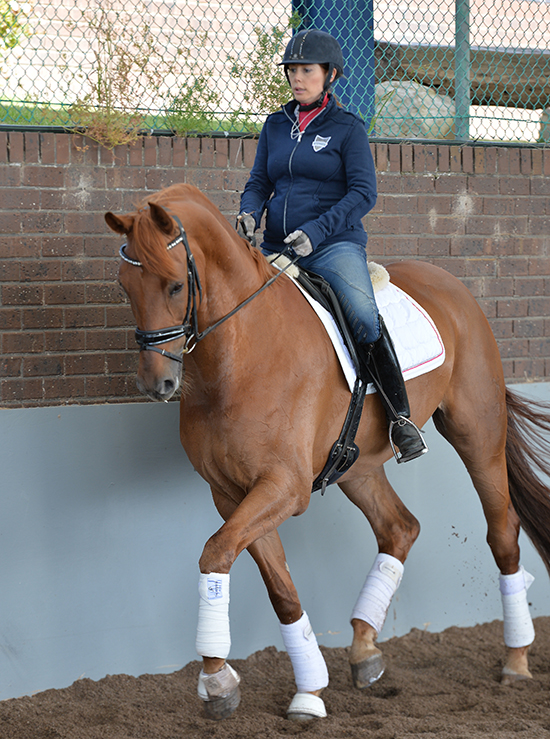
Rubinell is a Hanoverian mare, imported to Australia as a foal, more work with her and Hayley follows…
“Do lots of transitions, over and over, walk-trot, half-halt, directly into the walk and trot on again so you get an immediate reaction of your leg. Trot, trot, build up some energy and recycle that through the hindquarters, then walk again. Don’t be afraid to play with the tempo in the trot. Don’t think you have to ride in one perfect tempo all the time.”
“Keep riding shoulder-in. It was good to go forward, but then you just let her straighten and fall forward. She does that big trot – which is good – but then use your shoulder-in to control it. Go forward, you want the dynamic within the horse to increase, not the horse to lengthen and go faster. Walk again and close her again. So you get the direct result without any detours.”
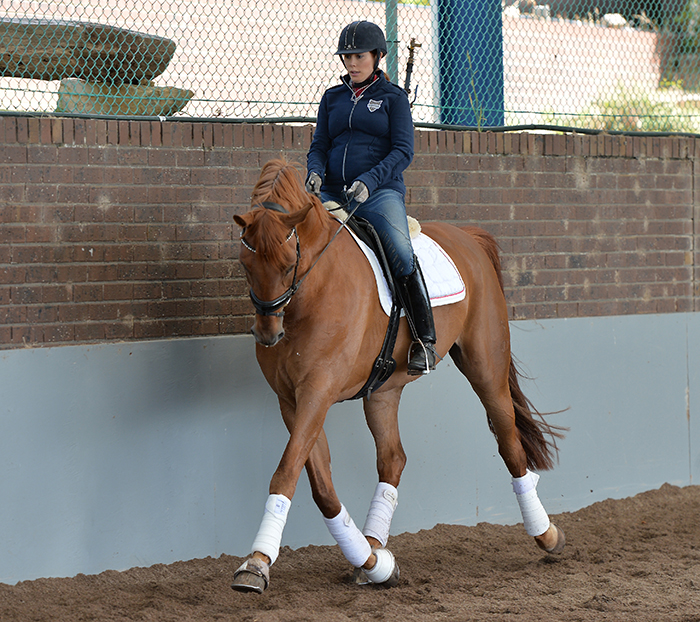
“Walk again and soften, trot again, go. As soon as she softens release your thigh a little, let her swing through your knees.”
“The neck is much better than it was yesterday. She is a little bit behind the vertical, however the under-neck is staying soft, she is not locking up every time you do a transition. It’s a process, it’s not perfect, but nothing is perfect. In the perfect world, which everybody writes about in books, it’s all fantastic, but that’s crap. There is no perfect world when you train horses. It would be nice if people would bring more common sense into training rather than thinking ‘the book says this, so we have to ride like this.’ That’s politically correct, but rubbish. It’s wonderful, but not the real world.”
“And trot again. You don’t need the big, long booming trot. She gives you three strides and walk – that’s better. Give her a pat. That was really good, because she came back, but she didn’t become stiff-legged. That’s the answer, if the range of motion goes upwards to more cadence, that’s what we want at Grand Prix level in four to five years. These details now are going to help you get there. Not the big trot. The big trot should just stay there, so she is able to access it. But the big trot breaks them. If you run around in big trot all the time, they’ll break. It’s not necessary. Connected, engaged, forward and backward engaged work, that’s what we are after.”
“She needs to stay on your track, within her body, whether you are on the second track or on the centreline, it doesn’t matter, but she needs to track up from behind into her withers. Even if she does shoulder-in, the hind legs still have to be pushing forward on the direct line. That’s really important.”
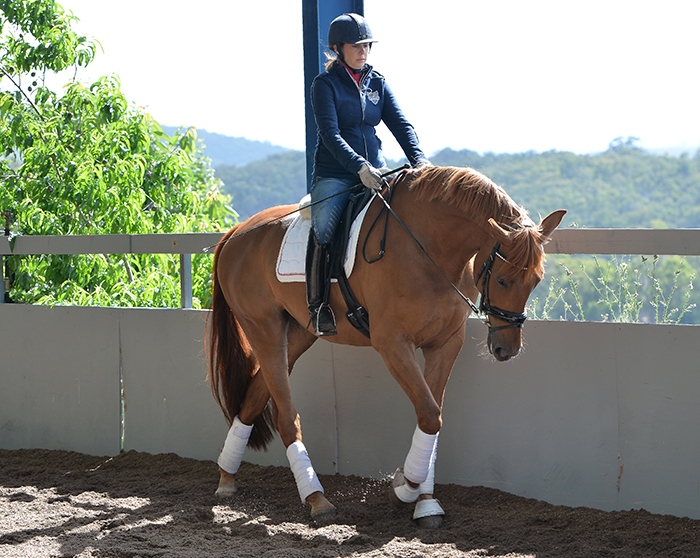
“Be soft; be kind – friendly but very on top of it. Not friendly and stop riding. You should be respectful with each other. Challenge her, but challenge her with respect.”
“If she gets insecure, if she is getting lost, you and her are separated. She is insecure. Horses by nature have different temperaments and personalities. Some of them are more in your face, some are careful. Horses survive by running away, so they are very aware of their environment. It is a completely normal horse thing. That’s why I don’t understand why in competitions in Australia, they don’t allow you to walk around the ring. In Germany this is normal. Every young horse that comes into a class is allowed to have a couple of minutes to walk around the arena. Over here, they are very anal about it. It is ridiculous. Some horses don’t care, that’s fine. But the sensitive horses, the horses you need to go to the higher levels with, they can be very aware of the environment, which makes them unsure. That’s why you as a rider have to be much clearer in what you are asking, so that they learn that you are the leader. In a herd situation there is always a boss, there is always someone who is leading. Horses work out where they are in a pecking order within the herd. Horses that are spooky and unsure will feel more comfortable if you give them a definite direction.”
“Most riders, if the horse does something wrong and they correct it, ‘no, that wasn’t what I wanted you to do.’ Why the heck don’t they show the horse what they do want it to do? Now. Then they don’t have to be correcting stuff and the horse doesn’t learn to do it wrong.”
“Give the horse information on what it should be doing. It depends how you ride, if you’re riding positively or negatively.”
“It’s the same with riders. If I sit here and tell you, ‘don’t do that, don’t do that’, you will not take on any of my information because it is negative and your brain doesn’t work like that. Try to be positive, train in a positive mode.”
“Shorten your reins; do not make her shorter in the neck. Your hands have to be a little kinder. Try to enhance the dynamics of your walk, without speeding. More activity, the hands stay together, don’t fiddle with her mouth. You want the neck to stay between your hands. You want the muscles to stay soft. So the horse can push through the withers with the muscles, the hind legs are activated and you get the belly up through the ribcage.”
“It is difficult for you, you ride on your own, you have no mirrors – so it is very hard for you to see where her frame is. So you have to be careful. The human identification of the situation is in front, what you see in front of you. That’s what you rely on to give you a barometer of what is happening. But your feeling of what is happening in front is not necessarily a barometer of what is happening behind. Horses need to get strong into the contact. Today you are getting the half-halts working because she is pushing forward into the bit. Then you can address the hindquarters. It is a positive pull. You need contact, so ride and re-adjust the balance to the backend, and the horse will get less strong.”
“Half-halt, left canter. Organise the body and the pressure, use your inside leg to canter. I’d rather she came up a little bit in front, rather than buried herself and pulled over her front legs. Think of renvers, the whole time in the canter. The nose stays in front of you, shorten your reins again. Renvers – always think of riding the right front leg forward. The left leg is leading in the canter, but I want you to ride the outside of the horse forward – the feeling of renvers. The horse is being forced to over-straighten, she is not drifting to the left, use your inside leg, half-halt, upward forwards, not backwards downwards.”
“Use your corner. Give her a push, push your belly button forward and down. So you are not holding her back and pushing her with your back. You don’t push with your back. Her back should come to your seat; you need to sit soft. You need to sit heavy, but not against the horse. Sit by using your abdominals, the front of your tummy as much as you can. Use your leg to push her towards your belly button. Sit and half-halt into that. So the frequency in the canter becomes more intense, she jumps with a better cadence. Up-up, up-up – and walk.”
“There’s a German word, ‘verständlich’, which is a really good word, it means ‘easy, understandable’. It is just uncomplicated to do, don’t make such a big fuss of it with over-collecting. Concentrate on the purity of the gaits and feeling through the pressures in the body and just do it.”
“Think of renvers on the circle and move the shoulder towards me. The frequency and the dynamics in the canters are what you are trying to improve. Don’t forget your half-halts, it never ends. Half-halt, push-on, half-halt-push-on. A million billion every day! Re-adjust the body position, re-adjust the longitudinal position, both at the same time, you correct both of those.”
The mare swaps leads.
“She changes and that is normal, she is struggling. It is not going to happen in two days. She has to practise. And transition to walk – that was horrible! It was like a western sliding stop. Canter again. Take your time, rhythm in your canter, the horse cannot read your mind. She worked hard yesterday, she is getting tired and uncomfortable and you are expecting her to be as good as yesterday. Sorry honey, but that is not going to happen. You have to be more lenient with her; it’s a process. They give to you, and it’s glorious, but they don’t do that every day. We get intolerant because we expect that to happen every day.”
“It is not the time you spend on the horse, it’s what you do in that time. You can ride for two hours and have little ten-minute blocks of intensity in that period, maybe for three times or maybe four times for an advanced horse. If you overload the muscles, like decreasing the circle in the canter is really a workload, it stresses the muscles. If you take it over the point, they actually go into lockup and they can’t do it. Then you are starting to get the problems and the horse is being ‘naughty and bad’. But it is because they are physically unable to do the what you are asking. If you let her take a walk and let everything stretch and relax, the muscles have a chance to re-energise. Then you can do another section…”
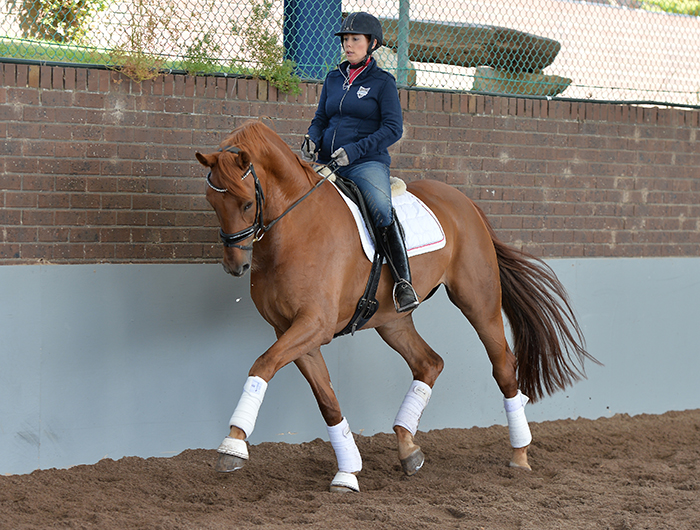
“It is like interval training. Anybody who is an event rider knows that you don’t gallop all the time. Too many dressage riders ride only for half an hour and they try to do everything. And then you get those horses that become like marionettes. They do everything but they are quite stuck in their bodies. Those are the schoolmasters. If you are working on schooling a potential athlete you will have to have a completely different attitude. Training an athlete means cross-training, stretches… not just the cardio. It’s very complex management. As the rider you have to be a good manager and a good physio.”
“The details you apply now will follow you forever. It starts now, train it now – not just somehow. Anyone can get through the Grand Prix test, the ones who win get through with these details. The fine line that separates them from the rest is the detail. It is like the little kid taking a colouring book and crayons, and then we have Leonardo da Vinci, who does the masterpiece. They are both painting, but it is the detail. That’s what you are after, the Leonardo da Vinci of painting. Think about it!”
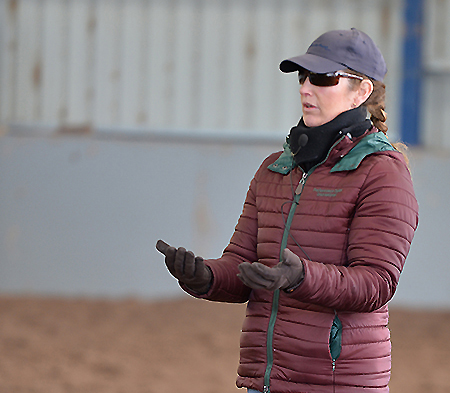
“Don’t give your reins away in order to go forward. She must canter past your contact. Half-halt up through your rein, not just accelerating only. When you accelerate take care of the quality of the body. You are sitting on a dressage horse, so take care of the quality of what’s underneath you despite the acceleration. Lengthen in the stride is not necessarily an acceleration issue. You have to take care of exactly what you are asking the horse to do. Again that involves attention to detail.”
“The mare has this super big, really good walk. This is great, because now you are getting the idea of collection in the walk. This is a great start, as I said to you before, this is how you will be getting into the piaffe one day. Her brain understands the signal you are giving her.”
“Don’t think of stopping the canter; go into riding the walk. In downward transitions everybody stops the gait they are in. No, ride forwards to the next gait, even if it is a walk. And canter again, outside rein and renvers. Inside leg, half-halt and upwards. And transition to walk, forward to the walk, half-halt – much better. She is waiting for you, ‘here I am’ and it was good, because you were right there. Give her a long rein and pat her.”
“One thing I often say to people is this: Think of having a wall and you have twenty doors on this wall – twenty openings – all the doors are closed. You open door number 15. The horse is bouncing around, fiddling and struggling, and you are saying, yes you are hitting every door, but you are not quite getting door number 15. The second the horse gets door number 15, the door must be open. And there must be a reward, meaning the friendliness, in exactly that second. The more experienced and the better a rider is, then they can have seventy holes in the wall and expect the horse to go to number 19. A very unexperienced rider may have two holes, a right and a left hole. If they can manage to hit the right-hand hole, then that’s a huge step. It is very relative to the skill of the rider. A three-year-old horse with a skilled rider can still hit hole number 15 of twenty doors. But a three-year-old horse with an unskilled rider – that is really a challenge. A skilled horse with an unskilled rider needs a trainer who can help them to get to door number 15. It’s very relative how the whole thing fits together.”
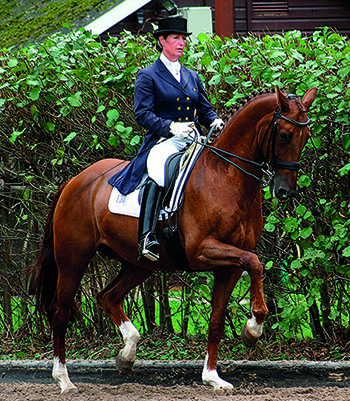
Leonie and one of her Grand Prix stars, Orion
“That’s how you get horses better; you do have to stress them to a certain degree. You cannot train them by just patting them and ride on a long rein all the time. They won’t go to Grand Prix doing that. I don’t care who comes and teaches and tells you, ‘oh this is how to find the perfect world’ – it does not exist. You get the job done, but with empathy for the horse. Sometimes you have to be after them and give them a good kick up the backside so they put in more of an effort, but the second they come to the party, you have to be ‘good, here we go’ and go with them, that is the reward. Some riders try stopping them again and it becomes a catch-22 situation, the horse does not have a chance do it right and they either shut off or start doing really naughty things. It is quite complex and it depends on your mind as well. The biggest part of the game is what is in your head. Get yourself sorted out, put your emotions in a bag, put it on the fence post while you ride. You can take them with you when you’re done. Don’t take it out on your horse. Very few professional people can shut that part of themselves down. Even I, at home, sometimes think, ‘okay you know what, I’ll just get off, the horse can go on the lunge now and I’ll start again tomorrow.’ The horse is having a rough day or is frisky, or is tight because it has become cold, who knows? You don’t watch them 24/7. We do make mistakes. Sometimes you get off and you think that it was really not that good today. But you have to be honest with yourself, nobody is perfect, even riders who ride at the Olympics.
“You are using the whip to enhance the moment; it is not a punishment in that sense. They are trying to figure things out; it doesn’t mean they should be punished for doing that. I want the horses to come to the whip; I don’t want them to be aggravated by it. In the long run, when I touch them they should come forward, I use it to enhance that moment. That’s my way of thinking. I don’t want to make them numb. If I numb them and I ride in a Grand Prix without a whip, they won’t go. Little spurs are good, I ride with tiny spurs and yes, I ride with a whip and create a moment of ‘get your act together’. But a point comes when use of the whip must be overruled, because I am riding better and the horse is coming to my aids. If I go back into my old mode and ride behind the horse again, then it hasn’t done me any good, I go back to making them numb.”
“A million people do shoulder-in every day, one gets a 10 and one gets a 2. The 2 is the little kid’s colouring book and the 10 is the Da Vinci’s Mona Lisa. Try to ride with the detail of the Mona Lisa.”
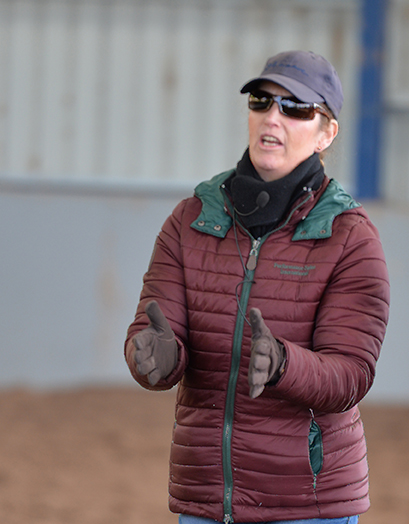
And it was time for Hayley and Rubi to take a well-earned rest, and time for me to have a little chat with Leonie…
Is that exhausting inside your brain? You are concentrating so long and I suppose you do it a couple of thousand times a year…
“I do it every day at home. And that’s just my thing and I love it. For me the teaching is the mental part of it, I’m trying to get into a rider’s head. The horse is giving me a lot of information. The rider goes blah, blah, whatever, I watch the horse go around and I know exactly what’s going on with the rider. I am more or less translating what the horse is telling me and I am then trying to, by jumping into the rider’s brain, get them to stop and make things happen and listen to me and let go. That’s the way I teach.”
“Some people can’t handle me, because I overload them, but if I have a rider who has clicked on and they can hook up to me, they suddenly go ‘oh my god’, and I ride with them. I try to use a lot of analogies because I cannot just tell them, ‘do this, don’t do that.’ I could do that, but if I use an analogy that they can relate to in daily life, like the kid and the colouring book or Da Vinci, it is very obvious and it is a visual thing. They can do something with it. Everybody has a different way of learning, same with horses.”
“My challenge is to try with every person to give them a little bit to make their world and their horses’ world better and to move them on. That’s what I like to do. I cannot change the world, but some people do progress, and then their students progress, and it becomes a big wheel that turns. That is becoming lost in the dressage world, we had Rehbein, we had Schultheis, we had Peilicke, we still have Zeilinger – those are the guys, they were really in there, they were riding. Yes, they were a bit tough on their horses, but they did get something done and they understood that you have to go through a horse, not just sit up there and ride around. Everybody can have their own idea, but maybe we all just settle down a bit and become a little bit more normal and start riding again.”
And with that, Leonie waves the next rider into the school, the wheel continues to turn…
Breed your own dressage star, choose a stallion from International Horse Breeders for your mare: www.ihb.com.au Stars like Fürstenball…
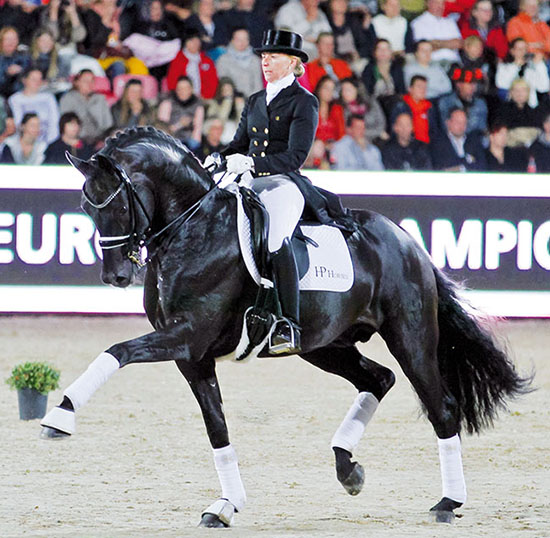


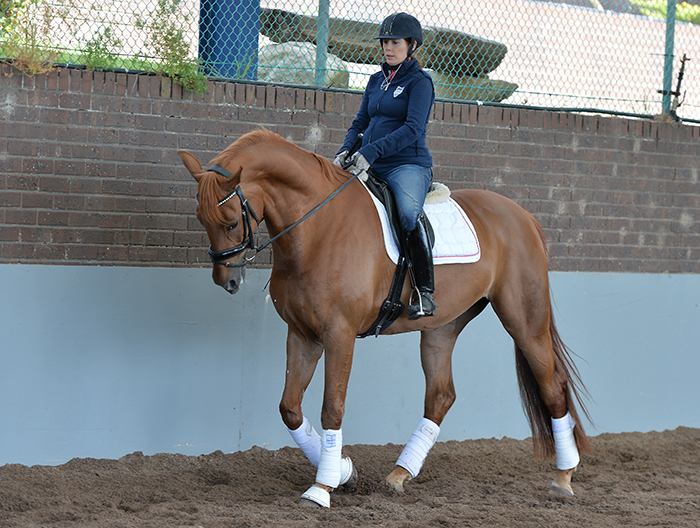
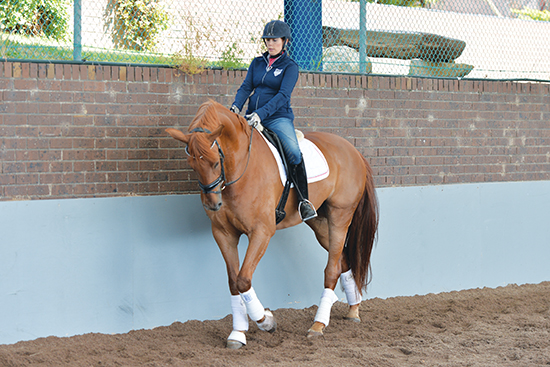
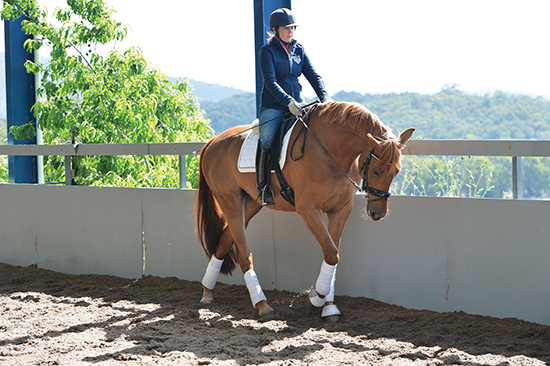
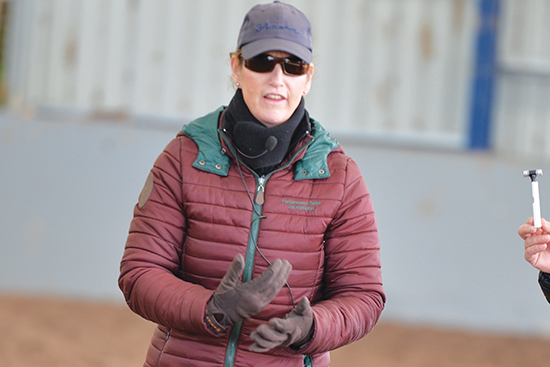

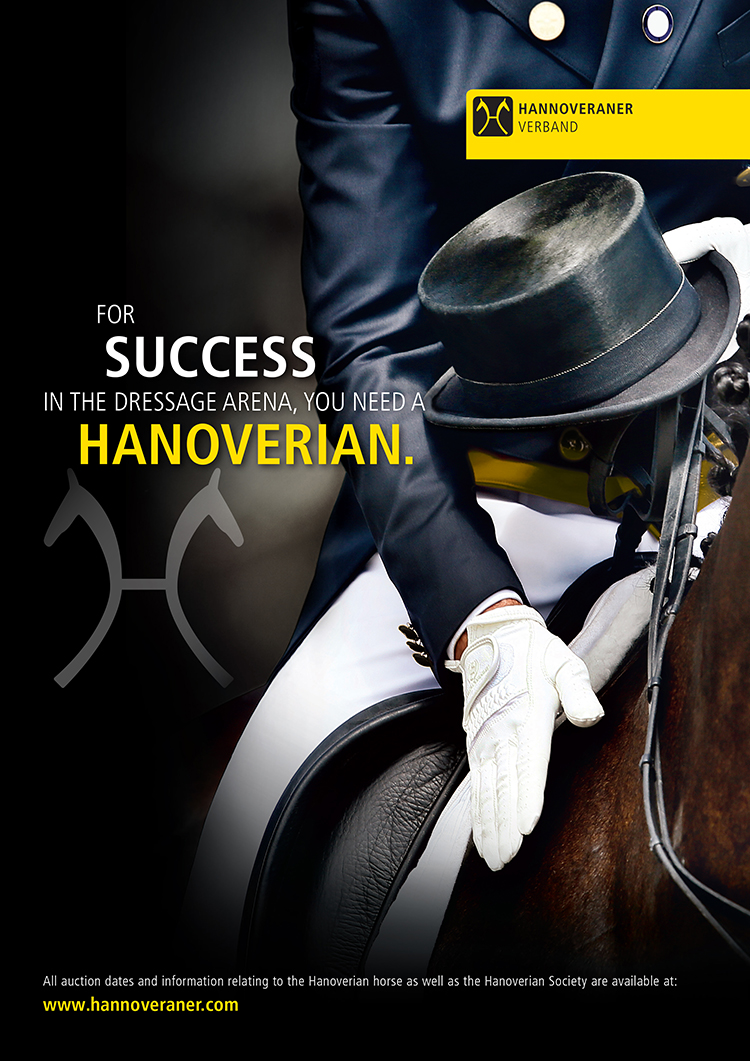
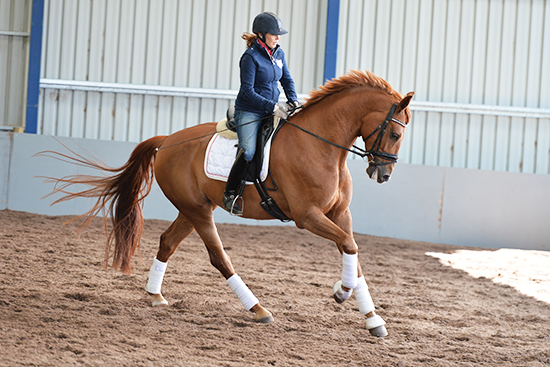
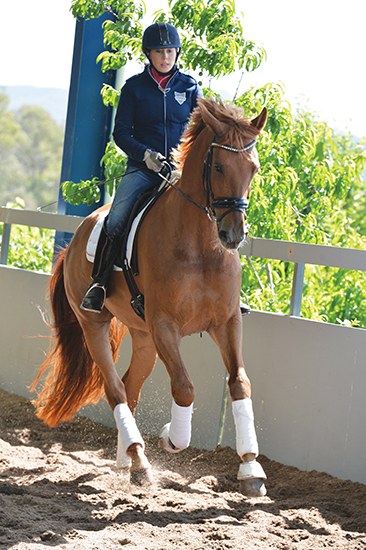
We also rode with Leonie. Myself, my daughter jorjia and a young rider client . We found Leonie to be an excellent trainer , who could adjust her training to each rider and breed of horse , who also tests your abilities and knowledge and allows you to achieve your goal settings . We are looking forward to further training with Leonie later in the year. Great article!
Dear Leonie, so many years have passed since Bonnie’s. I love hearing your name and hearing of your great success’.
I cherish the book you gave me when I left Alberta.
Cheers and continued success,
Sue Charles